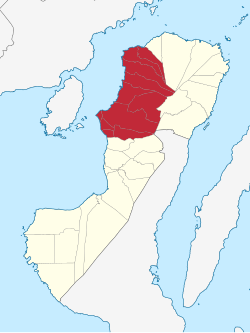This article needs to be updated. The reason given is: Bacolod is not classified as a metropolitan area by NEDA. (August 2024) |
Metro Bacolod | |
|---|---|
 Skyline of Urban Bacolod | |
 | |
| Country | Philippines |
| Region | Negros Island Region |
| Province | Negros Occidental |
| Cities | Bacolod Silay Talisay |
| Legislative districts | Lone District of Bacolod 3rd District of Negros Occidental |
| Barangays | 104[1] |
| Largest city | Bacolod |
| Government | |
| • Type | Metropolis |
| Area | |
• Total | 578.65 km2 (223.42 sq mi) |
| Population (2020)[3] | |
• Total | 840,170 |
| • Density | 1,452/km2 (3,760/sq mi) |
| Time zone | UTC+8 (Philippine Standard Time) |
Metro Bacolod (Hiligaynon: Kaulohan nga Bacolod; Tagalog: Kalakhang Bacolod) is the 8th-most populous and the 6th-most densely populated metropolitan area out of the 12 metropolitan areas in the Philippines. This metropolitan area as defined by the National Economic and Development Authority (NEDA) has an estimated population of 840,170 inhabitants as of the 2020 official census by the Philippine Statistics Authority.[3]
The metropolitan area is centered on Bacolod, the provincial capital, and the component cities of Silay and Talisay, all located in the province of Negros Occidental. As of 2005, Metro Bacolod has relatively high GDP shares, contributed ₱88,056,250 or about 7.3% of the country's gross domestic product (GDP). Metro Bacolod is among those identified by the National Framework for Physical Planning: 2001–2030 as one of the country’s industrial, financial and technological centers. It is ranked 4th among the six regions in terms of GDP contributions in 2005 and expanded. The Bacolod city government, the definition based on the 2020 official census of the Philippine Statistics Authority.[4][5]
- ^ Government of the Philippines. "Total Population by Province, City, Municipality and Barangay: as of August 1, 2007 (Region VI – Western Visayas)" Archived February 15, 2010, at the Wayback Machine, Philippine Statistics Authority, Republic of the Philippines, Retrieved on July 7, 2010.
- ^ "List of Cities". Archived from the original on April 29, 2011. Retrieved July 7, 2010.
- ^ a b Census of Population (2020). Table B - Population and Annual Growth Rates by Province, City, and Municipality - By Region. Philippine Statistics Authority. Retrieved July 8, 2021.
- ^ "Building Globally Competitive Metro Areas in the Philippines" (PDF). National Economic and Development Authority. August 30, 2007. Archived from the original (PDF) on October 4, 2013. Retrieved February 6, 2014.
- ^ "DAILY STAR: Top Stories". Archived from the original on February 3, 2018.